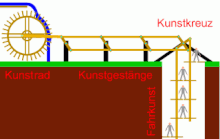Mining art
The mining art is the totality of all machines and technical systems in mining . A single device was referred to as art or artifacts . The term was used well into the 19th century, with the advent of steam engines and other modern devices, the term became increasingly uncommon. The term art has the meaning of the Greek techne and is contained in the word arts and crafts and was used in the engineering disciplines for both the work and the mastery of technology - the rules of art . The current concept of art is no longer used in this way.
Art types
There are different types of mining arts. Essentially, arts were developed in the context of dewatering for pumping the water out of the pits ( water art ), for transporting people ( driving art ), for ventilating mine structures via weather wheels , for conveying loads via a sweeping wheel and for crushing the conveyed material in Poch- or hammer mills used. The drive took place almost exclusively via water wheels ( artificial wheel , Kehrrad), which were often set up underground or in a bicycle room . Therefore, also in force art ponds and channels ( Art trenches ) as art, the water up to the mine zoom led, as well as linkage ( flatrod system ), the energy from the water wheel transferred to the mine. In addition to water power, wind turbines and windmills were used in wind art . The driving force of humans or horses was used in Göpeln .
Another, albeit significantly smaller, area of application was found in materials handling via arts in the saltworks . To extract salt, the brine had to be lifted from a well several meters deep. For this purpose pumps or bucket elevators driven by water wheels were used. However, the well and the water wheel were often spatially separated so that the force was transmitted through a so-called field linkage.
An art master who had to combine engineering knowledge and carpentry experience was responsible for the maintenance of all these systems . The maintenance and operation of the arts was the responsibility of the art servants .
In 1556 Georgius Agricola published in his book De re metallica libri XII ( Twelve books on mining and metallurgy ) over 250 woodcuts with extensive descriptions of all the mining arts known at the time.
See also
literature
- Georg Agricola : De Re Metallica Libri XII . Twelve books on mining and metallurgy. Unchanged reprint of the first edition by VDI-Verlag, 1928 edition. Marixverlag, Wiesbaden 2006, ISBN 3-86539-097-8 , sixth book, p. 120-188 (Latin).
- Helmut Wilsdorf: Cultural history of mining . An illustrated journey through times and continents. Glückauf Verlag, Essen 1987, ISBN 3-7739-0476-2 .


